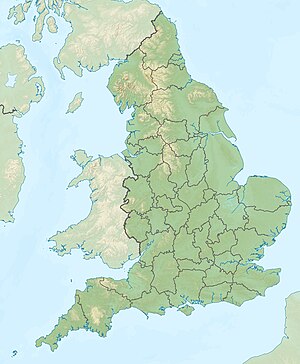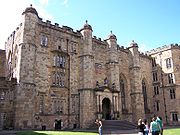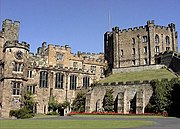Durham Castle
| Durham Castle | ||
|---|---|---|
|
Durham Castle with Durham Cathedral in the background |
||
| Castle type : | moth | |
| Standing position : | Episcopal Castle | |
| Place: | Durham | |
| Geographical location | 54 ° 46 '29 " N , 1 ° 34' 34" W | |
|
|
||
Durham Castle is a Norman castle in the city of Durham in County Durham , England . It stands on a hill above the River Wear across from Durham Cathedral .
history
The castle was originally built in the 11th century to protect the Bishop of Durham from attack. The north of England was, especially after the conquest of the country by the Normans in 1066 (beginning with the Battle of Hastings ), a "very wild" area. The castle is an example of the moth construction preferred by the Normans .
Premises
Big hall
Built in the early 14th century by Bishop Antony Bek , the Great Hall was the largest of its time in Great Britain until Bishop Richard Fox downsized it in the late 15th century. Today it is 14 m high and over 30 m long.
Chapels
Durham Castle has two chapels : Norman Chapel , built around 1078, and Tunstall's Chapel (named after Cuthbert Tunstall , leader of the English Church and two-time Bishop of Durham, 1474–1559), built in 1540.
Norman Chapel is the oldest accessible part of the castle. The architecture of the chapel is of Saxon origin, probably due to the fact that Saxons were forced to build it. In the 15th century, its three windows were almost completely blocked by the expansion of the keep . It was no longer used until 1841 and then served as a corridor for the Keep. During the Second World War , the Royal Air Force used the chapel as a command and observation post and its original meaning was discovered. Shortly after the war, the chapel was blessed again, and weekly services are still held today.
Tunstall's Chapel , as the larger of the two chapels, was more commonly used for church services. The bishops Cosin and Crewe expanded it in the late 17th century. In the back of the chapel you can still find some of the misericords (small wooden shelves that were supposed to make it easier to stand during church services) from the 16th century.
kitchen
The castle's kitchen and butter shop were set up under Bishop Richard Fox. They are among the northernmost examples of Gothic brick building in England.
University College
In 1837, Bishop Edward Maltby donated the castle to the newly established University of Durham as student accommodation and it was named University College . The Victorian architect Anthony Salvin reconstructed the crumbling Keep according to the original plans. Opened in 1840, it still serves as a dormitory for students today, making it the oldest inhabited university building in the world.
College students eat their meals in the Great Hall today, where the Durham Business School Alumni Annual Spring Ball takes place, while the basement serves as a bar. Both chapels are used today for both church services and theater events. The castle also houses the college library, the Palace Green Library . During the semester break, inexpensive accommodation and conference rooms are available. Otherwise, the castle is only accessible to the public as part of guided tours.
World Heritage
In 1986 the castle was declared a World Heritage Site by UNESCO, along with Durham Cathedral . The UK government justified the nomination:
- Few buildings in England can boast a longer history of continuous occupation than Durham Castle. Founded soon after the Norman Conquest, the Castle has been rebuilt, extended and adapted to changing circumstances and uses over a period of 900 years.
- (Few buildings in England can boast a longer history of continuous use than Durham Castle. Founded soon after the Norman Conquest, the castle has been reconstructed, expanded and adapted to changing circumstances over the course of 900 years.)







